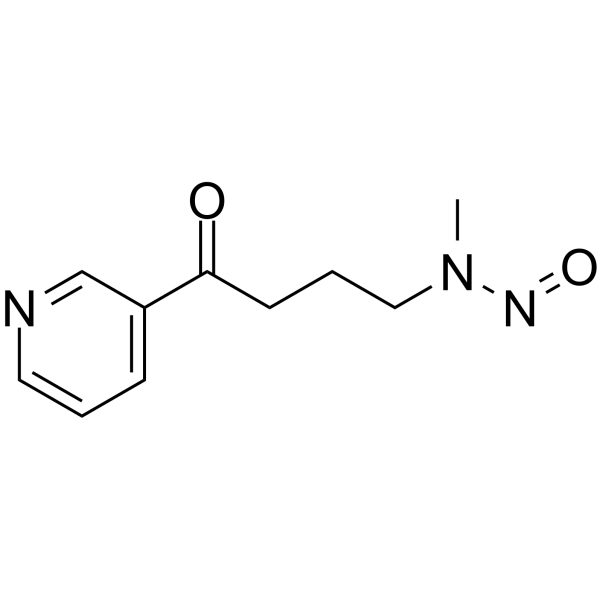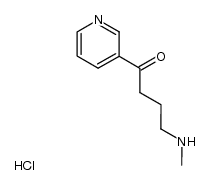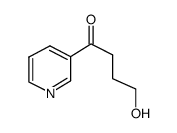nnk

nnk structure
|
Common Name | nnk | ||
|---|---|---|---|---|
| CAS Number | 64091-91-4 | Molecular Weight | 207.229 | |
| Density | 1.2±0.1 g/cm3 | Boiling Point | 423.9±25.0 °C at 760 mmHg | |
| Molecular Formula | C10H13N3O2 | Melting Point | 63-65ºC | |
| MSDS | Chinese USA | Flash Point | 210.2±23.2 °C | |
| Symbol |


GHS06, GHS08 |
Signal Word | Danger | |
Use of nnkNNK is a nicotine-nitrosated derivative. NNK simultaneously stimulates Bcl2 phosphorylation exclusively at Ser70 and c-Myc at Thr58 and Ser62 through activation of both ERK1/2 and PKCα[1]. NNK induces survival and proliferation of human lung cancer cells. NNK can be used for lung cancer mice model structure[2]. |
| Name | 4-(N-nitrosomethylamino)-1-(3-pyridyl)butan-1-one |
|---|---|
| Synonym | More Synonyms |
| Description | NNK is a nicotine-nitrosated derivative. NNK simultaneously stimulates Bcl2 phosphorylation exclusively at Ser70 and c-Myc at Thr58 and Ser62 through activation of both ERK1/2 and PKCα[1]. NNK induces survival and proliferation of human lung cancer cells. NNK can be used for lung cancer mice model structure[2]. |
|---|---|
| Related Catalog | |
| Target |
Human Endogenous Metabolite |
| In Vitro | NNK (100 pM; 0-60 min) stimulates activation of PKCα and MAPKs ERK1/2 that directly induce c-Myc phosphorylation[1]. NNK (100 pM; 96 hours) enhances proliferation of cells expressing WT but not AA c-Myc mutant[1]. Western Blot Analysis Cell Line: NCI-H82 cells[1] Concentration: 100 pM Incubation Time: 0-60 min Result: Stimulated activation of PKCα and MAPKs ERK1/2 that directly induced c-Myc phosphorylation. Apoptosis Analysis Cell Line: H1299 lung cancer cells[1] Concentration: 100 pM Incubation Time: 96 hours Result: Enhanced proliferation of cells expressing WT but not T58A/S62A c-Myc mutant. |
| References |
| Density | 1.2±0.1 g/cm3 |
|---|---|
| Boiling Point | 423.9±25.0 °C at 760 mmHg |
| Melting Point | 63-65ºC |
| Molecular Formula | C10H13N3O2 |
| Molecular Weight | 207.229 |
| Flash Point | 210.2±23.2 °C |
| Exact Mass | 207.100784 |
| PSA | 62.63000 |
| LogP | 0.09 |
| Vapour Pressure | 0.0±1.0 mmHg at 25°C |
| Index of Refraction | 1.557 |
| Storage condition | Amber Vial, -20°C Freezer |
| Stability | Stable. Incompatible with strong oxidizing agents. |
CHEMICAL IDENTIFICATION
HEALTH HAZARD DATAACUTE TOXICITY DATA
MUTATION DATA
|
| Symbol |


GHS06, GHS08 |
|---|---|
| Signal Word | Danger |
| Hazard Statements | H301-H317-H351 |
| Precautionary Statements | P280-P301 + P310 |
| Personal Protective Equipment | Eyeshields;Faceshields;full-face particle respirator type N100 (US);Gloves;respirator cartridge type N100 (US);type P1 (EN143) respirator filter;type P3 (EN 143) respirator cartridges |
| Hazard Codes | Xn |
| Risk Phrases | R26/27/28;R45 |
| Safety Phrases | S45-S53 |
| RIDADR | UN 2811 |
| RTECS | OB6465000 |
| Packaging Group | II |
| Hazard Class | 6.1 |
|
~43% 
nnk CAS#:64091-91-4 |
| Literature: Pathak, Tanmaya; Thomas, Noel F.; Akhtar, Mahmoud; Gani, David Tetrahedron, 1990 , vol. 46, # 5 p. 1733 - 1744 |
| Precursor 1 | |
|---|---|
| DownStream 1 | |
|
Reactive oxygen species-mediated breast cell carcinogenesis enhanced by multiple carcinogens and intervened by dietary ergosterol and mimosine.
Free Radic. Biol. Med. 80 , 12-26, (2015) Most breast cancers occur sporadically due to long-term exposure to low-dose carcinogens in the diet and the environment. Specifically, smoke, polluted air, and high-temperature cooked meats comprise ... |
|
|
Mechanisms of tumor-promoting activities of nicotine in lung cancer: synergistic effects of cell membrane and mitochondrial nicotinic acetylcholine receptors.
BMC Cancer 15 , 152, (2015) One of the major controversies of contemporary medicine is created by an increased consumption of nicotine and growing evidence of its connection to cancer, which urges elucidation of the molecular me... |
|
|
Tobacco-specific N-nitrosamine exposures and cancer risk in the Shanghai Cohort Study: remarkable coherence with rat tumor sites.
Int. J. Cancer 134(10) , 2278-83, (2014) The tobacco-specific nitrosamines N'-nitrosonornicotine (NNN) and 4-(methylnitrosamino)-1-(3-pyridyl)-1-butanone (NNK) are potent carcinogens for the rat esophagus and lung, respectively. Consistent w... |
| 4-[Methyl(nitroso)amino]-1-(3-pyridinyl)-1-butanone |
| Nicotine-derived nitrosamine ketone |
| 1-Butanone, 4-(methylnitrosoamino)-1-(3-pyridinyl)- |
| 4-(n-nitrosomethylamino)-1-(3-pyridyl)-1-butanone |
| 4-(methylnitrosamino)-1-(3-pyridyl)-1-butanone |
| N-Nitrosonornicotine ketone |
| NNK |
| Ozone/NNK |
| MFCD00274580 |
| N-methyl-N-(4-oxo-4-pyridin-3-ylbutyl)nitrous amide |
| 1-Butanone, 4-(methylnitrosamino)-1-(3-pyridyl)- |
| 4-[Methyl(nitroso)amino]-1-(pyridin-3-yl)butan-1-one |

 CAS#:59578-62-0
CAS#:59578-62-0